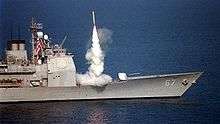USS Shiloh (CG-67)
 USS Shiloh | |
| History | |
|---|---|
| Name: | USS Shiloh CG-67 |
| Namesake: | Battle of Shiloh |
| Ordered: | 16 April 1987 |
| Builder: | Bath Iron Works |
| Laid down: | 1 August 1989 |
| Launched: | 8 September 1990 |
| Acquired: | 24 April 1992 |
| Commissioned: | 18 July 1992 |
| Homeport: | Yokosuka, Japan |
| Motto: | Making Excellence a Tradition |
| Status: | in active service |
| Badge: |
 |
| General characteristics | |
| Class and type: | Ticonderoga-class cruiser |
| Displacement: | Approx. 9,600 long tons (9,800 t) full load |
| Length: | 567 feet (173 m) |
| Beam: | 55 feet (16.8 meters) |
| Draft: | 34 feet (10.2 meters) |
| Propulsion: |
|
| Speed: | 32.5 knots (60 km/h; 37.4 mph) |
| Complement: | 33 officers, 27 Chief Petty Officers, and approx. 340 enlisted |
| Sensors and processing systems: |
|
| Armament: |
|
| Aircraft carried: | 2 × Sikorsky SH-60B or MH-60R Seahawk LAMPS III helicopters. |
USS Shiloh (CG-67) is a Ticonderoga-class guided missile cruiser of the United States Navy, named in remembrance of the Battle of Shiloh in the American Civil War. She was built at the Bath Iron Works in Bath, Maine. The vessel is commanded by Captain Adam M. Aycock.
With her guided missiles and rapid-fire cannons, she is capable of facing and defeating threats in the air, on the sea, or the ashore, and underneath the sea. She also carries two Seahawk LAMPS multi-purpose helicopters, mainly for anti-submarine warfare, (ASW).
History
On 3 September 1996, while in the Carl Vinson carrier battle group, the Shiloh launched 6 Tomahawk cruise missiles in Operation Desert Strike against Iraq.

She deployed with the Battle Group again in July 2002, and was among the first cruisers to launch missiles in Operation Iraqi Freedom. In March 2003 Shiloh was assigned to Cruiser-Destroyer Group Three.[1] The Shiloh returned to her homeport San Diego, California on 25 April 2003, ending an unusually long nine-month deployment.
In January 2005, she participated in Operation Unified Assistance, rendering aid to those who suffered from the 26 December 2004 tsunami off the coast of Aceh, Indonesia. The Shiloh was one of the first American ships to arrive on scene.
On 22 June 2006, a Standard Missile Three (or SM-3) launched from Shiloh intercepted a multi-stage ballistic missile launched from the Pacific Missile Range Facility at Barking Sands, Hawaii.[2]
In August 2006, she arrived on station at Yokosuka Naval Base in Yokosuka, Japan, replacing the USS Chancellorsville, as part of a joint U.S.-Japanese ballistic missile defense program.[3]
On 8 July 2009, Petty Officer 1st Class Christopher Geathers fell from the ship's fantail into Tokyo Bay while rigging shore power cables. A two-and-a-half-day search failed to locate Geathers and he was declared missing and later was declared dead.[4] A Navy investigation, led by Rear Admiral Kevin Donegan, commander of Task Force 70, found that the accident was preventable, in part because Shiloh personnel had observed Geathers working without proper safety equipment, but had failed to intervene. Nevertheless, the report did not recommend disciplinary action against any of the ship's crewmembers.[5]
In Fiction and Literature
The ship is featured prominently in the 2012 naval thriller, Fire of the Raging Dragon, by Don Brown.
The ship is mentioned in Highschool of the Dead with the JDS Kirishima And JDS Kongo When the 3 ships intercept ICBS'S.
References
- ↑ "World Navies Today: US Navy Aircraft Carriers & Surface Combatants". Retrieved May 2012
- ↑ "A Standard Missile Three (SM-3) is launched from the guided missile cruiser USS Shiloh (CG 67)". U.S. Navy. 22 June 2006. Retrieved 2010-04-03.
- ↑ http://news.yahoo.com/s/nm/20060829/wl_nm/arms_japan_usa_dc_2 Archived 1 September 2006 at the Wayback Machine.
- ↑ Slavin, Eric, "Navy calls off search for USS Shiloh sailor", Stars and Stripes, 13 July 2009.
- ↑ Slavin, Erik, "Report: Sailor’s overboard death was preventable", Stars and Stripes, 6 January 2010.
This article includes information collected from the Naval Vessel Register, which, as a U.S. government publication, is in the public domain.
External links
- Official Homepage
- Yokosuka Naval Base Community Website
- USS Shiloh webpage
- Maritimequest USS Shiloh CG-67 Photo Gallery
- An article: Shiloh sailors make star wars fan film
- USS Shiloh News
- Yarnall, Paul R.; Tom Bateman (25 January 2010). "USS Shiloh (CG 67)". NavSource Naval History. Retrieved 2010-04-03.
- "USS Shiloh (CG 67)". Naval Vessel Register. NAVSEA Shipbuilding Support Office (NAVSHIPSO). 8 August 2007. Retrieved 2010-04-03.
| Wikimedia Commons has media related to USS Shiloh (CG-67). |